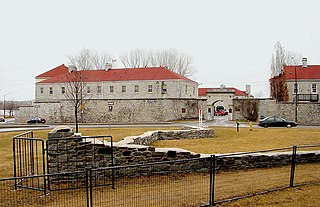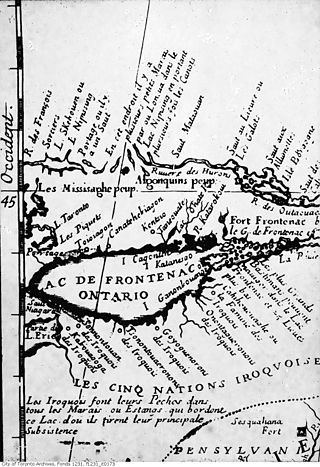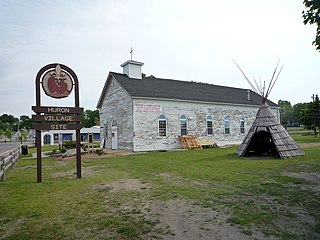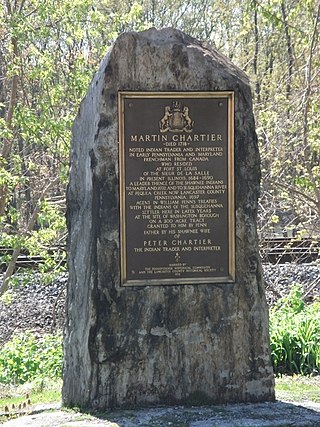Related Research Articles

René-Robert Cavelier, Sieur de La Salle, was a 17th-century French explorer and fur trader in North America. He explored the Great Lakes region of the United States and Canada, and the Mississippi River. He is best known for an early 1682 expedition in which he canoed the lower Mississippi River from the mouth of the Illinois River to the Gulf of Mexico; there, on 9 April 1682, he claimed the Mississippi River basin for France after giving it the name La Louisiane. One source states that "he acquired for France the most fertile half of the North American continent". A later ill-fated expedition to the Gulf coast of Mexico gave the United States a claim to Texas in the purchase of the Louisiana Territory from France in 1803. La Salle was assassinated in 1687 during that expedition.

Louis de Buade, Comte de Frontenac et de Palluau was a French soldier, courtier, and Governor General of New France in North America from 1672 to 1682, and again from 1689 to his death in 1698. He established a number of Forts on the Great Lakes and engaged in a series of battles against the English and the Iroquois.

Henri de Tonti, also spelled Henri de Tonty, was an Italian-born French military officer, explorer, and voyageur who assisted René-Robert Cavelier, Sieur de La Salle, with North American exploration and colonization from 1678 to 1686. de Tonti was one of the first explorers to navigate and sail the upper Great Lakes. He also sailed the Illinois and the Mississippi, to its mouth and thereupon claimed the length of the Mississippi for Louis XIV of France. He is credited with founding the settlement that would become Peoria, Illinois. De Tonti established the first permanent European settlement in the lower Mississippi valley, known as Poste de Arkansea, making him "The Father of Arkansas".
The Beaver Wars, also known as the Iroquois Wars or the French and Iroquois Wars were a series of conflicts fought intermittently during the 17th century in North America throughout the Saint Lawrence River valley in Canada and the Great Lakes region which pitted the Iroquois against the Hurons, northern Algonquians and their French allies. As a result of this conflict, the Iroquois destroyed several confederacies and tribes through warfare: the Hurons or Wendat, Erie, Neutral, Wenro, Petun, Susquehannock, Mohican and northern Algonquins whom they defeated and dispersed, some fleeing to neighbouring peoples and others assimilated, routed, or killed.

Le Griffon was a sailing vessel built by French explorer and fur trader René-Robert Cavelier, Sieur de La Salle in the Niagara area of Canada in 1679.

Fort Frontenac was a French trading post and military fort built in July 1673 at the mouth of the Cataraqui River where the St. Lawrence River leaves Lake Ontario, in a location traditionally known as Cataraqui. It is the present-day location of Kingston, Ontario, Canada. The original fort, a crude, wooden palisade structure, was called Fort Cataraqui but was later named for Louis de Buade de Frontenac, Governor of New France who was responsible for building the fort. It was abandoned and razed in 1689, then rebuilt in 1695.

Teiaiagon was an Iroquoian village on the east bank of the Humber River in what is now the York district of Toronto, Ontario, Canada. It was located along the Toronto Carrying-Place Trail. The site is near the current intersection of Jane Street and Annette Street, at which is situated the community of Baby Point.

Joseph-Antoine le Fèbvre, sieur de La Barre was a French lawyer and administrator best known for his disastrous three years as governor of the colony of New France (Quebec).

Jacques-René de Brisay, Marquis de Denonville was the Governor General of New France from 1685 to 1689 and was an important figure during the intermittent conflict between New France and the Iroquois known as the Beaver Wars.

Ganondagan State Historic Site, also known as Boughton Hill, is a Native American historic site in Ontario County, New York in the United States. Location of the largest Seneca village of the 17th century, the site is in the present-day Town of Victor, southwest of the Village of Victor. The village was also referred to in various spellings as Gannagaro, Canagora, Gandagora, Gandagaro and Gannontaa.

Fort de Buade was a French fort in the present U.S. state of Michigan's Upper Peninsula across the Straits of Mackinac from the northern tip of lower Michigan's "mitten". It was garrisoned between 1683 and 1701. The city of St. Ignace developed at the site, which also had the historic St. Ignace Mission founded by Jesuits. The fort was named after New France's governor at the time, Louis de Buade de Frontenac.
Jean de Lamberville was a Jesuit priest who arrived in New France from France in 1669. He was the older brother of Jacques de Lamberville. Jean became a missionary to the Onondagas and had success in converting their chief, Garakontie. He also was well known for his knowledge in the medical treatments of his time.
Madeleine de Roybon d'Allonne was an early settler of New France. She was the first European woman to own land in Ontario. There is a memorial plaque in her honour located in Lennox and Addington County.

Fort Chécagou, or Fort Chicago, was a purported seventeenth-century fort that may have been located in what is now northeastern Illinois. The name has become associated with a myth that the French continuously maintained a military garrison at a fort near the mouth of the Chicago River, and the future site of the city of Chicago on the southwestern shore of Lake Michigan. Some sources mention that the fort was built in 1685, and that Henri de Tonti sent his aide, Pierre-Charles de Liette, as commander of the fort through 1702. Although this fort was marked on a number of eighteenth century maps of the area, there is no evidence that it ever existed at the described location, but may have instead actually been located at the mouth of the St. Joseph River, on the southeastern shore of Lake Michigan.
Jean Bochart de Champigny, Sieur de Noroy et de Verneuil, was Intendant of New France from 1686 to 1702. His mandate was one of the longest, rivalling those of Hocquart and Bégon. He served as intendant during the terms of Governors Denonville, Frontenac, and Callière, and was in office at the time of King William's War, the Lachine Massacre, the Battle of Quebec, and the Great Peace of Montreal.

Fort Crevecoeur was the first public building erected by Europeans within the boundaries of the modern state of Illinois and the first fort built in the West by the French. It was founded on the east bank of the Illinois River, in the Illinois Country near the present site of Creve Coeur, a suburb of Peoria, Illinois, in January 1680. It was destroyed on April 16, 1680 by members of La Salle's expedition, who mutinied and abandoned it, fearful of being attacked by the Iroquois League as the Beaver Wars extended into the area.

Bead Hill is an archaeological site comprising the only known remaining and intact 17th-century Seneca site in Canada. It is located on the banks of the Rouge River in Rouge Park, a city park in Toronto, Ontario. Because of its sensitive archaeological nature, it is not open to the public, nor readily identified in the park. It was designated a National Historic Site in 1991, eventually becoming a unit of the national park system in June 2019.
Between 1665 and 1670, seven Iroquois settlements on the north shore of Lake Ontario in present-day Ontario, collectively known as the "Iroquois du Nord" villages, were established by Senecas, Cayugas, and Oneidas. The villages consisted of Ganneious, Kente, Kentsio, Ganaraske, Ganatsekwyagon, Teiaiagon, and Quinaouatoua. The villages were all abandoned by 1701.

Martin Chartier was a French-Canadian explorer and trader, carpenter and glove maker. He lived much of his life amongst the Shawnee Native Americans in what is now the United States.

Tinawatawa, also called Quinaouatoua, was an Iroquois village of the Seneca people on the western end of the Niagara corridor, described as "a fertile flat belt of land stretching from western New York to the head waters of the Thames River". It was located on the western end of Lake Ontario.
References
- ↑ "G - Canadian Indian Villages, Towns and Settlements". Access Genealogy: A Free Genealogy Resource. 13 July 2011. Retrieved 4 February 2014.
- ↑ Frederick Webb Hodge (1 July 2003). Handbook of American Indians North of Mexico Volume 1/4 A-Z. Digital Scanning Inc. pp. 487–. ISBN 978-1-58218-748-8.
- 1 2 McLeod, Alan (August 30, 2019). DISCUSSION DRAFT The Third Crossing Project Report on Indigenous Consultation (PDF) (Report). Retrieved June 29, 2020.
- ↑ Robinson, Percy J. (2019). Toronto During the French Regime. Toronto: University of Toronto Press. p. 243. doi:10.3138/9781487584504-019. ISBN 9781487584504 . Retrieved Feb 18, 2022.
- ↑ Grant Karcich (30 March 2013). Scugog Carrying Place: A Frontier Pathway. Dundurn. pp. 36–. ISBN 978-1-4597-0752-8.
- ↑ Francis Parkman (1927). Count Frontenac and New France Under Louis XIV. Library of Alexandria. pp. 133–. ISBN 978-1-4655-2326-6.
- ↑ Berthold Fernow; Edmund Bailey O'Callaghan (1855). Documents Relating to the Colonial History of the State of New York. Weed, Parsons. pp. 362–.
- ↑ Adams, Nick (1986). "Iroquois Settlement at Fort Frontenac in the Seventeenth and Early Eighteenth Centuries" (PDF). Ontario Archaeology (46): 9–10. Archived from the original (PDF) on 13 September 2017. Retrieved 4 February 2014.
- ↑ Barr, Daniel P. (2006). Unconquered: The Iroquois League at War in Colonial America. Westport CT: Praeger Publishers. p. 87. ISBN 9780275984663.
- ↑ Marcel, C.M.W. "Iroquois origins of modern Toronto". counterweights. Retrieved 4 February 2014.